Related Research Articles
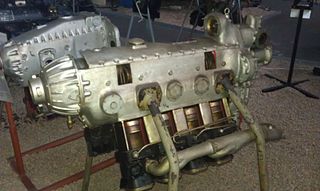
The Hirth HM 508 was an air-cooled, eight-cylinder, 60° cylinder bank angle inverted-V aircraft engine built in Germany in the 1930s. It had a bore and stroke of 105 mm × 115 mm and developed 210 kW (280 hp) at 3,000 rpm.
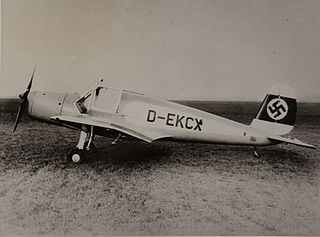
The Arado Ar 79 was a German aircraft of the 1930s, designed as an aerobatic two-seat trainer and touring aircraft.
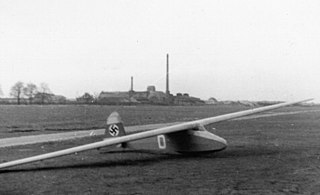
The Akaflieg München Mü13 Merlin and Akaflieg München Mü13 Atalante were gliders designed and built in Germany from 1935. A motor-glider version of the Merlin was converted by the addition of a small engine in the nose, as the Mü13M Motormerlin. Post-war development as the Mü13E entered production as the Scheibe Bergfalke.
The Akaflieg Stuttgart F-1 Fledermaus (Bat) was a glider designed and built in Germany from 1932.
The Akaflieg Stuttgart fs16, nicknamed Wippsterz was a glider aircraft that was designed and built in Germany from 1936. Only one example of the design was constructed.
The Akaflieg Stuttgart fs17 was a glider aircraft that was designed and built in Germany from 1936. It notably featured a prone seating position for its pilot.
The Akaflieg Stuttgart fs18a was a glider designed and built in Germany from 1938. It was characterized by a gull wing and was the first glider to have a retractable undercarriage. Only one example of the design was constructed.
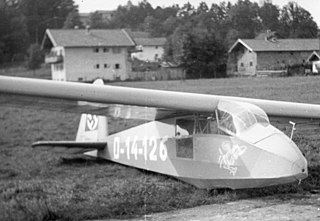
The Akaflieg München Mü10 Milan is a two-seat glider aircraft that was designed in Germany in 1934. Only one copy of the design was built.
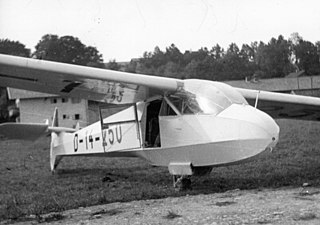
The Akaflieg München Mü15 was a two-seat glider designed and built in Germany in the late 1930s, loosely based on the Mü10. A longer span version, the Akaflieg München Mü20 was still in the design stages when further work was abandoned.
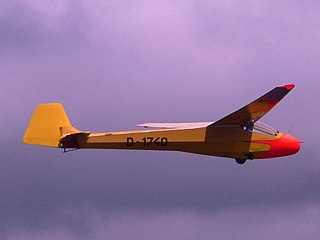
The Akaflieg München Mü17 Merle is a single-place glider aircraft that was designed and built in Germany from 1938.

The Arado Ar 77 was a German twin-engined monoplane, designed as an advanced training aircraft from 1934.
The DFS Seeadler was a German flying boat sailplane designed by Hans Jacobs of the Deutsche Forschungsanstalt für Segelflug (DFS). It was version of the 1935 DFS Rhönadler, with a new fuselage and strongly gulled wings to keep them clear from spray. The aircraft was first flown in the summer of 1935, test piloted by Hanna Reitsch, and towed by a Dornier Do 12.
The Akaflieg Darmstadt D-28 Windspiel was a single-seat, high-performance sailplane designed in Germany in the early 1930s. Intended to exploit a growing understanding of thermal soaring, it was small and manoeuvrable, with a 12 m span; silk-covered for lightness, it weighed less (empty) than its pilots. It held the world straight-line distance record for a time in 1934.
The Akaflieg Darmstadt D-30 Cirrus was an aerodynamically advanced single seat sailplane with a very high aspect ratio wing and a pod and boom fuselage. Built in Germany just before World War II, it was intended as a record breaker and duly set a new world out-and-return distance record in 1938.
The Schneider Grunau 7 Moazagotl was a high-performance sailplane designed in Germany in 1933 specifically for fast, long distance flying using strong thermals. In 1937 it came second in the first World Gliding Championships, having previously made a flight of 300 km (186 mi).
The Schneider ESG 31 Schlesierland (Silesia) was a representative of a group of German, 16 m span, one-off gliders, built by Schneider in Grunau from 1929 to at least 1931.

The Akaflieg Berlin B5 was a glider built in Germany in the late 1930s. It featured a high-wing, cantilever sailplane configuration of all-wood construction, with cantilevered gull-wings, retractable landing-gear, all-moving-tail, dive air-brakes.

The Akaflieg Berlin B6 was a glider built in Germany in the late 1930s. It featured a high-wing, cantilevered mid-wing sailplane configuration with Junkers-flaps, retractable landing gear, all moving tail, dive air brakes, wood and steel body.
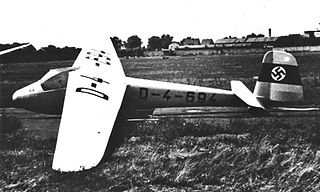
The Akaflieg Berlin B8 was a German sailplane built in the late 1930s for the 1939 Olympic games glider competition in Rome. It was a high-wing sailplane with a cantilever shoulder-wing, dive air-brakes and all wood construction.
The Kroeber M4 Köller was a 2-stroke air-cooled horizontally-opposed piston engine designed and built by Dr. Kroeber & Sohn G.m.b.H. in Germany in the late 1930s. The M4 proved relatively popular, for powering the ultra-light aircraft and motor-gliders in vogue during the 1920s and 1930s.
References
- 1 2 3 Vogelsang, C. W. (1935). Handbuch des Motor- und Segelfliens (PDF). I. Postsdam: Akademische Verlogsgesellschaft Athenaion m.b.h. pp. 212–3.
- 1 2 3 Schneider, H. (1936). Flugzeug-Typenbuch. Handbuch der deutschen Luftfahrt- und Zubehör-Industrie (PDF). Leipzig: Herm. Beyer Verlag. pp. 70–71.
- ↑ "Schneider Grunau 8" . Retrieved 23 November 2014.
- ↑ Schneider, Helmut (1944). Flugzeug-Typenbuch. Handbuch der deutschen Luftfahrt- und Zubehör-Industrie (in German) (Sonderausg ed.). Leipzig: Herm. Beyer Verlag. pp. 338–339. ISBN 381120484X.